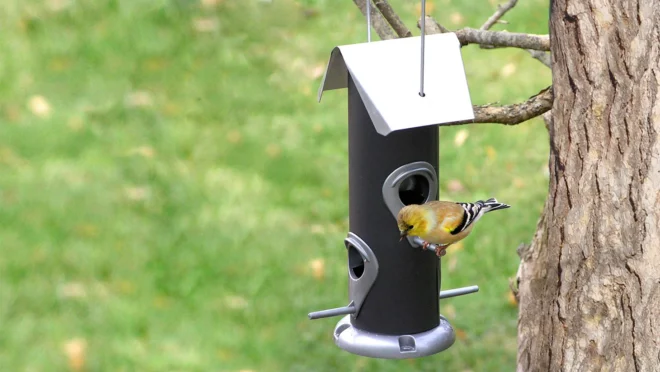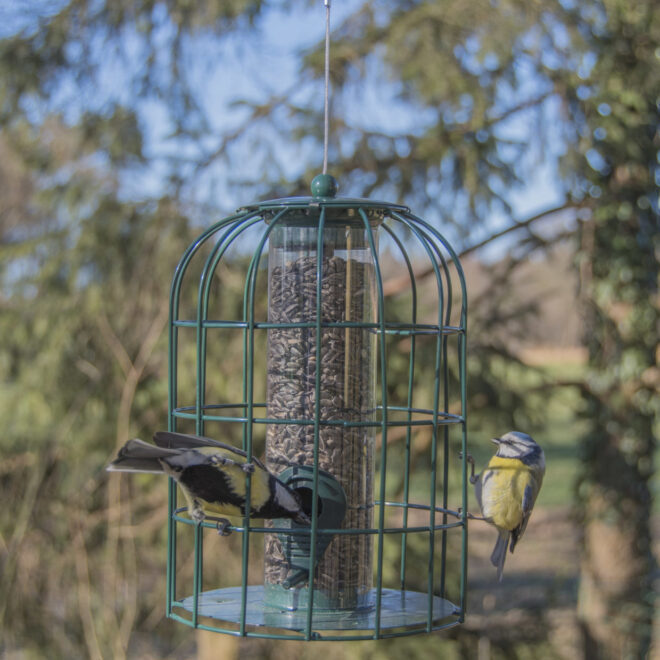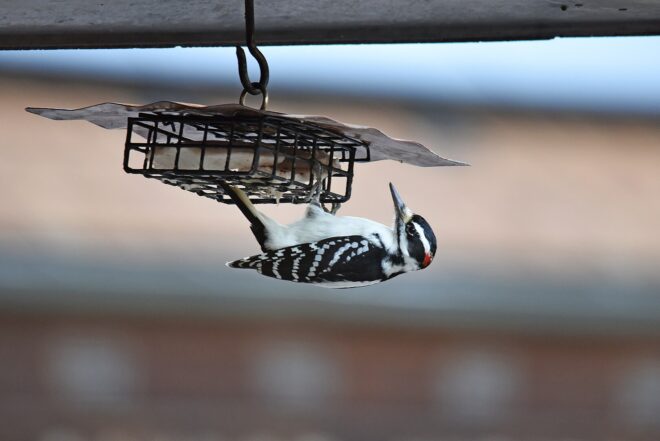PROTECT YOUR DNA WITH QUANTUM TECHNOLOGY
Orgo-Life the new way to the future Advertising by AdpathwayFor many nature enthusiasts in the U.S., a vibrant backyard bird community is a source of immense joy. The flash of a cardinal, the cheerful chatter of chickadees, or the acrobatic antics of a hummingbird can transform even the smallest urban balcony into a thriving natural sanctuary. However, those with limited outdoor space often face a unique challenge: how to attract and sustain a diverse avian population without overwhelming their yard/balcony/window ledge. The good news is, even the tiniest yard or other outdoor area doesn’t mean tiny aspirations for birdwatching. With thoughtful selection and strategic placement, even the most modest of spaces can become a feathered paradise.
This article investigates the best bird feeders specifically designed for tiny yards across the United States. We’ll explore various types, highlighting their space-saving features, the birds they attract, essential considerations like squirrel-proofing and maintenance, and how to create an inviting environment even with limited square footage.
Understanding Your Tiny Canvas: What to Consider
Before diving into specific feeder types, it’s crucial to assess your tiny yard thoroughly. Consider the following list and possibly make some notes.
Available Surface Area
Do you have a small patch of grass, a paved patio, a balcony, or simply a window? This will dictate whether you opt for hanging, pole-mounted, or window feeders.
Sunlight Exposure
Where does the sun hit throughout the day? Some seeds can spoil quickly in direct, prolonged sunlight, while others thrive. You should never put hummingbird feeders in full sun, however.
Proximity to Cover
Birds feel safest when a feeder is near shrubs, trees, or other vegetation, offering quick refuge from predators. Even a large potted plant can serve this purpose.
Predator Presence
Are there outdoor cats or other common predators in your area? This will influence the height and design of your feeder.
Squirrel Activity
This is often the biggest battle in bird feeding. Squirrels are persistent and resourceful, making squirrel-proof features a top priority for most small-yard birders. Read our guide for more info on effective ways to keep squirrels away from your bird feeders.
Ease of Cleaning
Dirty feeders can harbor bacteria and spread disease, so choosing a feeder that is easy to disassemble and clean regularly is paramount for bird health. Flat bird feeders are more likely to spread disease, so you may want to avoid these.
Top Feeder Types for Space-Constrained Yards
Given the constraints of a tiny yard, maximizing vertical space and choosing compact designs are key. Here are some of the most effective feeder types.
1. Window Feeders: Your Up-Close & Personal View
 Photo by Kristina Blokhin
Photo by Kristina BlokhinFor urban dwellers with no yard at all, or those simply seeking an intimate birdwatching experience, window feeders are a revelation. These feeders attach directly to your window glass with strong suction cups, offering unparalleled views of your feathered visitors.
These feeders are the ultimate in space-saving. They take up zero ground or hanging space, making them ideal for apartments or homes with small patios. They will typically attract smaller, nimble birds like chickadees, titmice, finches, nuthatches, and even wrens. You can get larger ones now that will even accommodate doves, as in the photo above.
 Photo via ebay
Photo via ebayWe recommend filling the feeder with black oil sunflower seeds as they are universally popular. If you are in an area with finches, Nyjer (thistle) seed in a small mesh sock feeder can also attract goldfinches. When purchasing one of these feeders, look for durable, clear plastic construction. Some models have perches or even small trays.
Regular cleaning is essential as they are highly visible, and any mold or dirt will be apparent. Suction cups need to be strong and re-applied periodically to ensure secure attachment. Some models may struggle with heavier birds or high winds.
2. Small Tube Feeders: Sleek & Simple
 Photo via Heathoutdoors
Photo via HeathoutdoorsTube feeders are a classic for a reason: their vertical design holds a good amount of seed while taking up minimal horizontal space. When selecting a feeder for a tiny yard, opt for shorter, narrower models.
The vertical orientation of these feeders is inherently space-efficient. They can be hung from shepherd’s hooks, porch hooks, or even well-placed tree branches. Excellent for chickadees, titmice, finches, siskins, they will also sometimes attract cardinals if the perches are sturdy enough.
Black oil sunflower seeds, shelled sunflower seeds (less mess), and safflower are all good choices to encourage a variety of birds. Choose models with multiple feeding ports and metal perches for durability. Clear tubes allow you to monitor seed levels. A strong hanging wire is crucial.
 Photo via Esschirt Design
Photo via Esschirt DesignWhile compact, ensure enough clearance around the feeder for birds to access ports comfortably. Squirrel baffles (domed or cone-shaped barriers) above or below the feeder or a cage around it are often necessary to deter persistent squirrels.
3. Suet Feeders: High-Energy, Low-Footprint
 Photo by Nosferattus
Photo by NosferattusSuet feeders offer a compact way to provide high-energy food, especially beneficial during colder months or for attracting insect-eating birds. They are typically small and can be hung individually or integrated into larger feeder designs.
Suet will primarily attract woodpeckers (Downy, Hairy, Red-bellied), nuthatches, chickadees, and wrens. Various suet cakes are available, often formulated with nuts, insects, or fruits. Avoid suet in nylon mesh bags, as birds’ feet can get tangled.
 Photo by Courtney Celley
Photo by Courtney CelleySimple wire cages or upside-down suet feeders (which deter larger birds like starlings) are common and effective in confined areas. However, suet can melt in hot weather, so placement in shade is recommended during summer. Ensure the feeder is securely hung to prevent it from swinging excessively.
Strategies for Tiny Yards
Beyond choosing the right feeder, here are some pro tips for maximizing your small bird haven.
Vertical Gardening with Feeders
Integrate hanging feeders with vertical plant displays. A tiered plant stand can hold multiple feeders at different heights, attracting a wider range of birds.
Shepherd’s Hooks & Wall Brackets
These allow you to position feeders away from windows or walls, creating dedicated feeding zones. Choose sturdy, rust-resistant materials.
Multiple Small Feeders vs. One Large
Instead of one large feeder that might attract dominant birds or be a target for squirrels, consider several smaller, specialized feeders. For example, a small tube feeder for finches, a suet feeder for woodpeckers, and a hummingbird feeder. This diversifies your offerings and reduces competition.
 Photo via Duncraft
Photo via DuncraftCleanliness is King
In a small space, hygiene is even more critical. Old, moldy seed or dirty water can quickly sicken birds. Establish a regular cleaning schedule (at least every two weeks, more often for platform and hummingbird feeders). Use a diluted bleach solution (9 parts water to 1 part bleach), rinse thoroughly, and allow to dry completely.
Water Source is Crucial
Don’t forget water! Even a small, shallow bird bath (or a simple dish of water changed daily) can attract as many birds as a feeder. Consider a hanging bird bath or a small, self-contained tabletop fountain.
Native Plants
Even in a tiny yard, a few native potted plants can provide natural food sources (berries, seeds, nectar) and shelter, making your space more appealing than just a feeder alone.
Squirrel Deterrence
While many feeders claim to be squirrel-proof, a determined squirrel can often find a way. Consider baffles on poles, strategically placed feeders away from jumping points (trees, fences), or even offering a separate distraction feeder for squirrels with less desirable (for birds) food like corn or peanuts in the shell.
Mind the Mess
Shelled sunflower seeds reduce hull mess. Place feeders over easy-to-clean surfaces or consider a tray underneath to catch discarded hulls and droppings.
Observation & Adjustment
Pay attention to which birds visit, what they eat, and how they interact with your feeders. Adjust your feeder types and seed offerings accordingly to cater to your local avian population.
 Photo via Jacobi Jayne
Photo via Jacobi JayneEthical Bird Feeding in Confined Spaces
While highly rewarding, bird feeding comes with responsibilities, especially in small spaces where birds may congregate closely. To avoid the spread of diseases, you should take action if your feeders become overcrowded. If you notice excessive numbers of birds, consider scaling back on the amount of food or adding another feeder to spread them out.
Be mindful of outdoor cats. If you have neighborhood cats, place feeders in locations that offer birds the best chance of escape (e.g., not directly next to dense shrubbery where cats can hide).
Lastly, always provide fresh, high-quality bird seed. Avoid cheap mixes with a lot of fillers like red milo or wheat, which most desirable birds will simply discard.
Final Thoughts
Transforming a tiny yard into a vibrant bird haven is entirely achievable with the right approach. By understanding the unique challenges and opportunities of limited space, and by thoughtfully selecting compact, easy-to-maintain, and squirrel-resistant bird feeders, you can invite a fascinating array of feathered friends right to your doorstep. From the intimate views of a window feeder to the busy activity around a cleverly baffled tube feeder, every small effort contributes to supporting local bird populations and brings the wonders of nature closer to home. So, even if your ‘yard’ is just a balcony or a window, embrace the possibilities, and get ready to enjoy the delightful world of backyard birdwatching.























 English (US) ·
English (US) ·  French (CA) ·
French (CA) ·